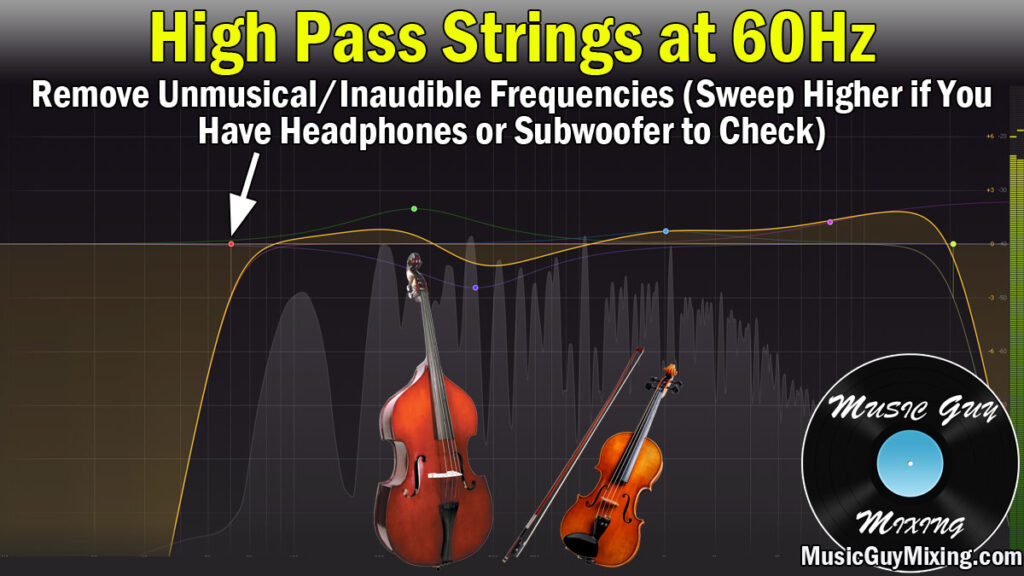Strings can be used as a bit of supporting low end, excitement in the top end, and as the focal point or simply an accenting piece in your mix. Regardless of how you’re using them in your mix, keep these tips in mind to better EQ strings.
How to EQ Strings
Let’s take this frequency by frequency in your mix to better identify the important areas when you EQ strings:

High Pass Around 60Hz

First I like to high pass filter my strings at 60Hz as a starting point. If you’re EQing a string bus or an inherently lower register string instrument like a cello, you may need to monitor this area to ensure you’re not cutting off the low end richness of these instruments.
If you’re just working on higher register instruments like violas or violins then you can afford to go higher.
Either way this move cleans up the low end in your mix and creates space for the instruments which need it when applicable.
Boost at 250Hz for Body

This is arguably the most important move to make when you EQ strings as a boost at 250Hz (approximately) adds to the body. What this effectively does is bring out more warmth and richness which we associate with strings in the low mids of your mix.
Again this will be a situational move depending on what instruments you have in your string section, but most instruments will benefit greatly from an added 2-3dB here in this range.
Cut at 500Hz

A cut at 500Hz provides two benefits. One it removes the kind of claustrophobic sound from your strings which you’ll hear when A/B split testing between the two. Not only does this clean up the mud, but this also places a greater emphasis on the higher end of the strings, making them sound cleaner.
This is the basis of subtractive EQ, we’re cutting out what isn’t working to better showcase and leave in what is.
Boost at 2k

We can bring out a lot of vibrancy when we EQ strings by simply giving a little boost to the 2k region.
There’s a lot of energy and liveliness here, maybe “excitement” is the best word, without bringing out the harshness that we’d find a little bit higher up in the 4k region.
As I show above, less is more here. You want to feel that life more than hear it, so try split testing it with and without with only a 1-2dB bump right here at most.
High Shelf at 8k

Call it transient cut or just a little percussive sizzle from the strings themselves, but a little high shelf around 8k can bring out some of the crispness in those strings.
Sometimes this move is all we need to get the strings to sit just right in our mix.
Low Pass at 20k

This is the very top end of the air bordering white noise that we feel on our strings. Technically that’s a bit lower, but to be safe I like to stick with 20k to create just a touch more headroom like I normally preach whenever I low pass.
As a general rule I do like to keep the top end intact on my strings along with cymbals and vocals in particular, but 20k is a safe spot to get the benefits on either side.
Apply these moves to correct problems or enhance the good that’s already there via some string EQ and your strings should be sitting and sounding a lot better in your mix.
Also make sure to grab my complete EQ cheat sheet for clear examples on how to EQ every single instrument in your mix.
